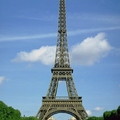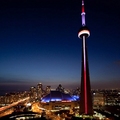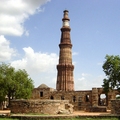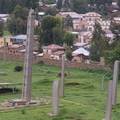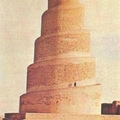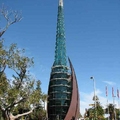Destinations / The Most Famous Towers in the World / The Leaning Tower of Pisa
The Leaning Tower of Pisa
In the field of miracles, as I recall, it was possible to grow a tree of gold. But this is a tale of life as the Square of miracles is the amazing Leaning Tower, the bell tower and still it cannot fall, fortunately. The bell tower of the cathedral of Our Lady of the Assumption, known worldwide as the Leaning Tower, is located on an area of Wonders 20 meters east of the cathedral . The area of miracles and wonders is a place where there are several sights of Pisa. Yet, the famous Leaning Tower is not the only decoration of this ancient Italian town.
Description
Despite its inclination, from an architectural point of view, the Tower of Pisa is quite a whole and complete structure. It demonstrates high artistic quality and it perfectly complements the architectural ensemble of the square of Miracles. The location of the tower is unusual-usually placed near the bell tower of the facade or along one side of the church. This is because the project during the construction of the tower took into account the location of other buildings planned on the square of the cathedral. The tower's height allows it to be a kind of visual center: its fine, staring up forms can be seen from anywhere in the area and far beyond its borders, making the tower a bridge between the secular urban space and the architecture of the nearby religious buildings. The building built the bell tower for 12 - 14 centuries, and the present appearance was as a result of multiple restorations performed centuries later. The work on the construction of the tower began on August 9, 1173. In accordance with the practice of the building in coastal regions, after laying the foundation before you continue building, waited a whole year.
History
Regarding the author's original draft, there is a disagreement. Some believe that it was a master Diotisalvi, who at the same time built a baptistery . This version is also confirmed by the analogy between the design and the decor of the two monuments. There is a version that the Leaning Tower of Pisa was built by Gerardi, a famous Italian historian Giorgio Vasari, but the tower is believed to be mentioned first in the draft of Bonanno Pisano. The first phase of the construction was interrupted when the fourth floor was built: already made themselves felt subsidence problems. The work continued in 1275 under Giovanni di Simone and Giovanni Pisano, who added onto three floors. To compensate for the tilt of the tower, the floors were built with some displacement in the opposite slope. The belfry was completed only after a century.
Wonderful construction
The construction of the Tower consists of two main parts: the base and the belfry . The base is a solid wall, decorated on the first floor gallery and big blind half-columns. The arches of the gallery of diamonds were placed of polychrome marble, centered with roses. In some places the walls of the base had been done by simple single windows. The tower has a single entrance, located on the west, between two powerful legs. The gates are flanked by pilasters with Corinthian capitals, supporting a carved architrave . The above semicircular arch with archivolt is decorated with relief and polychrome decoration. Above the first floor there are six floors with covered galleries. Inside the base is a hall of fish, so named because of the bas-relief depicting the fish on the wall. The hall has no ceiling and is illuminated by the sunlight that falls out of the hole in the center of the belfry . The tower has three steps. One of them leads to the first floor to the sixth, where the exit is on the outer gallery, the second leads to the sixth floor of the seventh, and the smallest staircase leads to the roof. In the belfry there are six bells, the heaviest of which weighs 3.6 tons and the lightest 300 kilograms. Most of the bells were made between the 16 and the 17 centuries, and the Leaning Tower of Pisa is the oldest bell made in the 13th century. The height of the tower is of 58.36 meters above the base and 55 meters above the ground level. Its weight is estimated at nearly 14 500 tons, and the center of gravity is located at a height of 22.6 meters. The foundation of the tower has a radius of 19.58 meters, while the inner hole -4.5 meters. Thus, the tower is based on a land area of 285 square meters and creates a pressure in 497 kPa. At this point the deviation from the vertical axis is of 5.5 degrees. It is caused by uneven subsidence foundation: the difference in the levels of its various parts reach 2.3 meters. As the center of the mass of the tower (an imaginary line drawn down the center of gravity of the tower) is still on the foundation, the tower did not fall. The sediment of the soil is associated with the peculiarities of its composition. This area is dominated by clay, which in the course of its geological development severe pressures haven’t been and therefore the area retained its strength. In addition, the compounded the presence of groundwater can cause a movement which can lead to unpredictable effects. Despite the fact that since the construction of the tower its slope increased markedly during its existence there were periods when it was in a static state, and even reduced the slope. The first major study on the inclination of the Tower was conducted by the British scientists in the early 19th century. They showed that the tower has reached its equilibrium, and no longer moves. However, after several years of imprisonment, for aesthetic reasons, it was decided to remove it from the base of the tower ground that not only violated the balance of the tower itself and caused further inclination, but also contributed to the displacement of the groundwater, resulting in other buildings in the area.In the 20th century the International Commission for the Conservation of the Leaning Tower was formed. The studies conducted by the commission, showed the reality of a danger of collapse and the bell tower in the period of 1990 - 2001 period was taken to strengthen. Some floors were fastened an iron frame, there are special counterweights weighing up to 900 tons preventing a possible further slope. It is believed that these measures have resulted in a tower to a position in which it was about 200 years ago and will keep the tower to the public for at least another three centuries. At the moment, the restoration of the stone tower comes to an end and it should be completed in 2010.
Others The Most Famous Towers in the World .
Others from The Most Famous Towers in the World
Since ancient times, this is an unspoken competition among architects to be the builder of the tallest building, of the longest bridge, of the most original house, of the most beautiful churches, etc.
Telling the truth, the architects began to receive recognition for their work only in recent times (since the era of modern times.
) Prior to that, until the time of the late Middle Ages, all the laurels battered rulers, barons, knights and other nobles, many of whom did not know what the project construction is.
There are several categories of buildings, which, thanks to their impressive size are among the most famous man-made objects.
These categories include the pyramids, bridges, towers and skyscrapers.
A tower is a high engineering construction.
The main differences from the other towers, tall buildings are the lack of braces (console design, fixed only at the bottom)and extremely low internal volume, and sometimes the entire volume of the tower is occupied by only one staircase.
As an engineering construction, the tower belongs to the antenna-mast structures.
The most commonly towers use antennas and feeder equipment for their location.
For example, mobile operators are placed on towers and relay panel antenna.
If the height of the antenna-mast structures (AMC), is more than 45 feet , it requires an electricity system.
This requirement REGA to ensure safety.
The creators of the Eiffel Tower gave the go-ahead starting the present stage of the competition for the title of " the biggest skyscraper or tower of the world.
" Built in 1889 it became the tallest (312m) building in the world.
Prior to its two thousand years the palm kept Pyramid of Giza (147m).
After the Eiffel Tower became the champions of the growth series: the Empire State Building (381m) in New York, Chicago Sears Tower (442m), Malaysia's Petronas Towers (452m), Taiwan's Taipei 101 (508m).
The latter was built in 2004 and held the title of the world's tallest skyscraper until 21 July 2007, when the line was broken by the cherished tower Burj Dubai in United Arab Emirates.
It rose to a height of 512 meters.
The construction of the tower is not yet complete, its completion is scheduled for late 2008.
According to the statements of architects, its height will reach a record high indeed - 808 meters.
The cost of the construction of the tower is estimated at one billion dollars and has lasted for almost four years.
The average rate of the construction of one floor lasted three days.
The tower and the adjacent buildings occupied a land of 200 hectares (it cost the owners of the building 20 billion dollars).
The tower will be equipped with 56 elevators (incidentally, the fastest in the world), boutiques, swimming pools, apartments class "luxury" hotels, and observation sites .
A distinctive feature is the construction of the international working teams: South Korean firm contractor, American architects, Indian builders.
Four thousand people had been involved in the construction.
The building of the tower was created in the shape of a trefoil - a symbol of life in the desert.
Its spire will be visible at a distance of sixty miles.
The Burj Dubai Tower will be the center of a large architectural complex.
Among the buildings of the huge complex (12ha), there will be an artificial lake, 30 thousand homes, a large park area, nine hotels.
Since ancient times, people seek height.
The evidence of this fact can be found everywhere - from the ancient Egyptian pyramids to the modern skyscrapers.
The legend of the Tower of Babel explains this tendency as theomachism - people wanted to reach heaven and defeat the gods.
Then they did not succeed, God sent the exuberant wind, tossing the tower, and mixed in a sentence all human languages.
But people have stubbornly continued to build high-rise structures - whether we wanted to prove his power, or trying to get closer to God, or seeking other worlds .
.
.
But as a person - just a man, and him, as did the ancient Romans, to err, it sometimes happened that tall buildings do not want to look up and just started to lean down to its creators.
So, many towers fell .
The reasons for the fall of the towers is the most different, many of them are connected with the peculiarities of the soil or with errors in the design and construction.
But, of course, each tower has an explanation of this feature.
A good tower is usually not one but several legends associated with its slope.
And certainly the leaning tower is a local (and sometimes known in the whole world) landmark.
If the tower identified its status, it is immediately placed in local guidebooks, and even brings considerable income.
We will cover the most famous bowing towers, each remarkable in its own way.
The most famous of falling towers are one of the oldest.
The tower is a bell tower and is part of the architectural ensemble, which also includes the cathedral, baptistery and cemetery.
All this is built of white marble and it simply shines in sunny weather .

